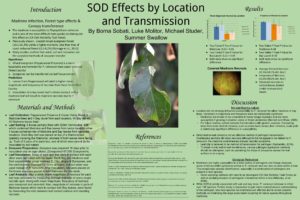Sudden Oak Death, also known as SOD, is quite prevalent in California and around my hometown. I became aware of this pathogen about 10 years ago, as Quercus agrifolia (coast live oak), Notholithocarpus densiflorus (tanoak) and Arbutus menziesii (pacific madrone) began dying off in astonishing numbers around the forest I call home. During my time studying biology at Santa Rosa Junior College, I dived into research about Sudden Oak Death and Phytophthora ramorum, the pathogen responsible for this phenomenon. Even though oak trees receive the most attention as the target of this pathogen, it can actually infect over 135 different species!
Working closely with fellow classmates and our professors, we attempted to uncover correlations between the magnitude of necrosis and geographic location. Additional research parameters included testing for leaf-to-leaf transmission and influence of leaf moisture levels and necrosis magnitude.
Below is the group poster presentation based on our experiment, I wrote the Discussion section:
